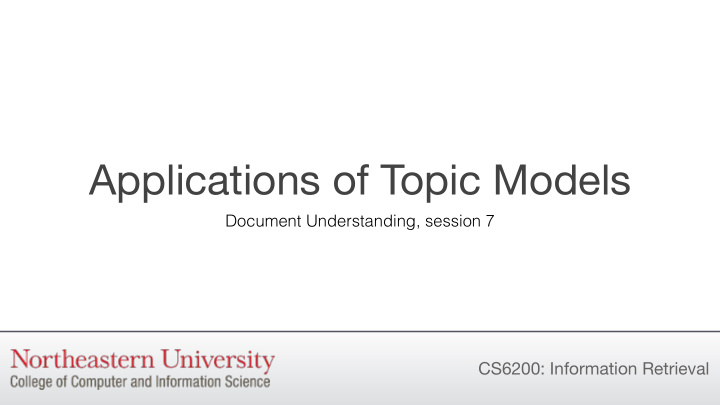



Applications of Topic Models Document Understanding, session 7 CS6200: Information Retrieval
Extending Topic Models PLSA is the most basic probabilistic topic model, and the idea has been usefully extended in many ways. • Its probability estimates have been regularized to improve output quality, most notably by Latent Dirichlet Allocation (LDA). M – number of documents • The document collection has been grouped in various ways (e.g. by language or N – document length publication date) to give topics more d – document, selected with P( d ) flexibility. z – topic, selected with P( z | d ) • Additional data can be included, such as w – word, selected with P( w | z ) sentiment labels, to condition the vocabulary distribution on new factors.
Latent Dirichlet Allocation Latent Dirichlet Allocation regularizes PLSA by using Dirichlet priors for its Multinomial topic distributions. Most topic models extend LDA, not PLSA. The distributions ⍺ and β are Bayesian posteriors, whose priors work like M – number of documents smoothing parameters to limit how N – document length extreme the document and vocabulary ⍺ – Multinomial dist. over documents distributions can become. β – Multinomial dists. over words The data likelihood is given by: θ – document, selected with P( d | ⍺ ) � N d z – topic, selected with P( z | θ ) M � � � � � P ( D| α , β ) = p ( θ d | α ) p ( z | θ d ) p ( w n | z , β ) dθ w – word, selected with P( w | z, β ) z d = 1 n = 1 David M. Blei, Andrew Y. Ng, and Michael I. Jordan. 2003. Latent dirichlet allocation.
Dynamic Topic Models Language usage changes over time, due to vocabulary drift and communities’ changing interests. Dynamic Topic Models capture that change by learning how topics drift as time goes on. Documents are grouped into time steps, according to their publication dates. The distributions over vocabulary and documents, ⍺ and β , are constrained to Three time steps of the model. ⍺ and β drift slightly in each time step. drift only gradually from the distributions in the preceding time step. David M. Blei and John D. Lafferty. 2006. Dynamic topic models.
Topics over Time The resulting topics show how language usage changes within each topic. David M. Blei and John D. Lafferty. 2006. Dynamic topic models.
Polylingual Topic Models Can we learn how topics are expressed by speakers of different languages? Polylingual Topic Models accomplish this by training on a collection of document tuples: each tuple has a representative document from each language. θ is a tuple of related documents, one in each language. φ is a language-specific vocabulary distribution. Tuples may be translations, or just Wikipedia pages in each language – even though they don’t cover the same subtopics. David Mimno, Hanna M. Wallach, Jason Naradowsky, David A. Smith, and Andrew McCallum. 2009. Polylingual topic models.
Polylingual Topic Models Two topics from EU Parliament Proceedings Two topics from Wikipedia (direct translations) (related pages)
Wrapping Up There are many ways to group documents or include additional data to extend topic modeling. The resulting topics are useful for data exploration and categorization. Topic models are not sufficient alone to yield good IR ranking performance, but they are a useful set of supplementary features for document understanding. Next, we’ll look at how to cluster documents together using any set of features.
Recommend
More recommend